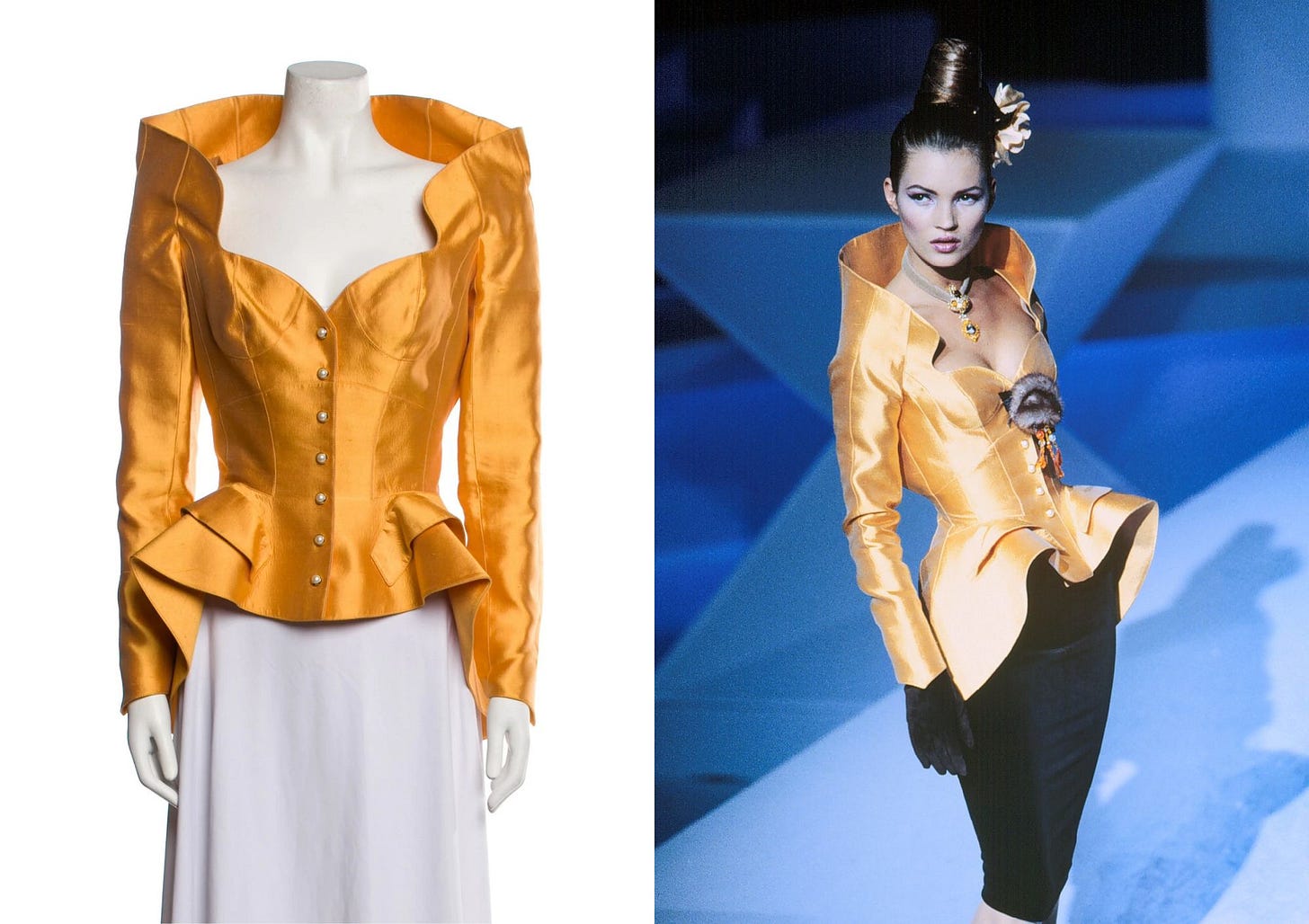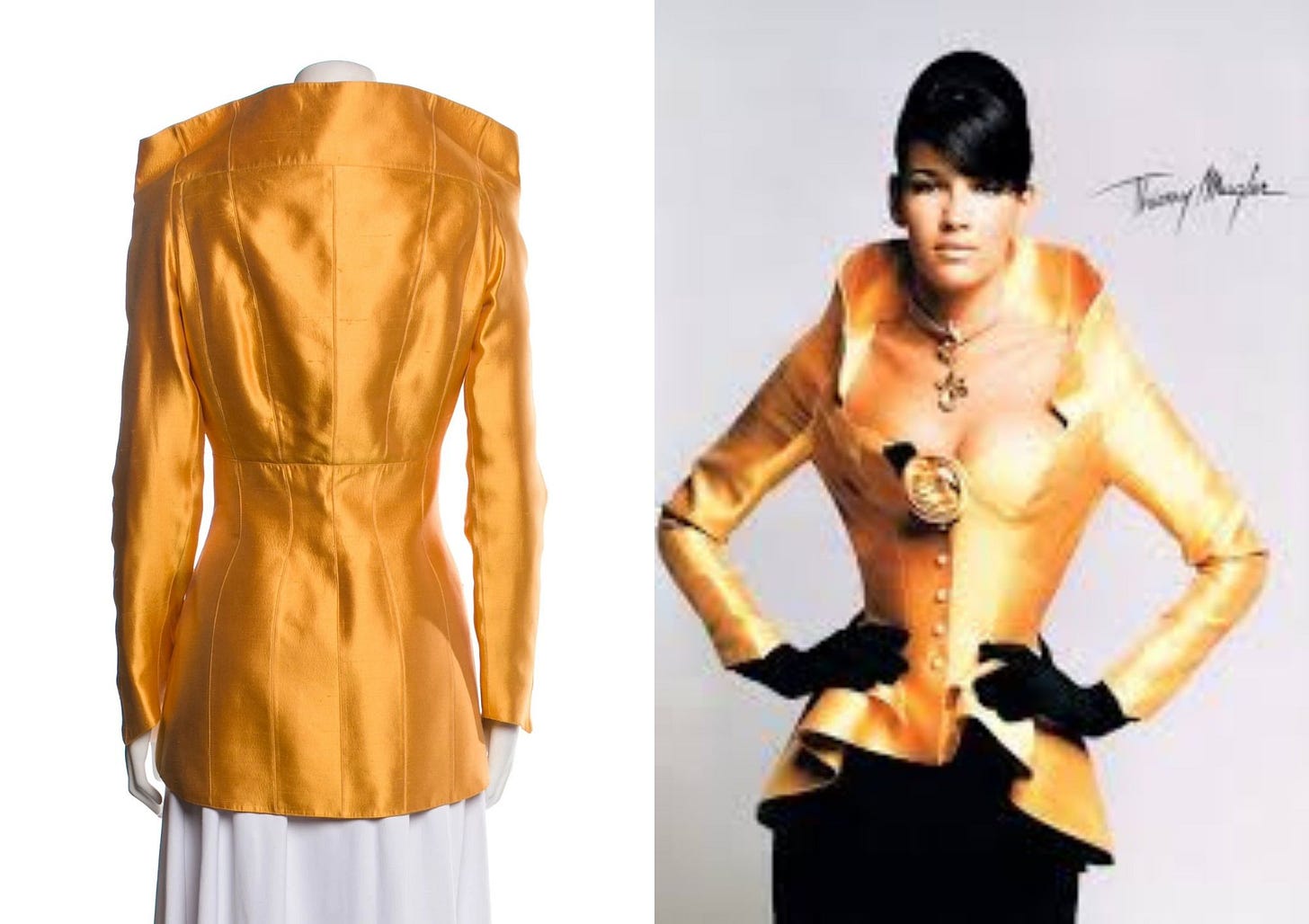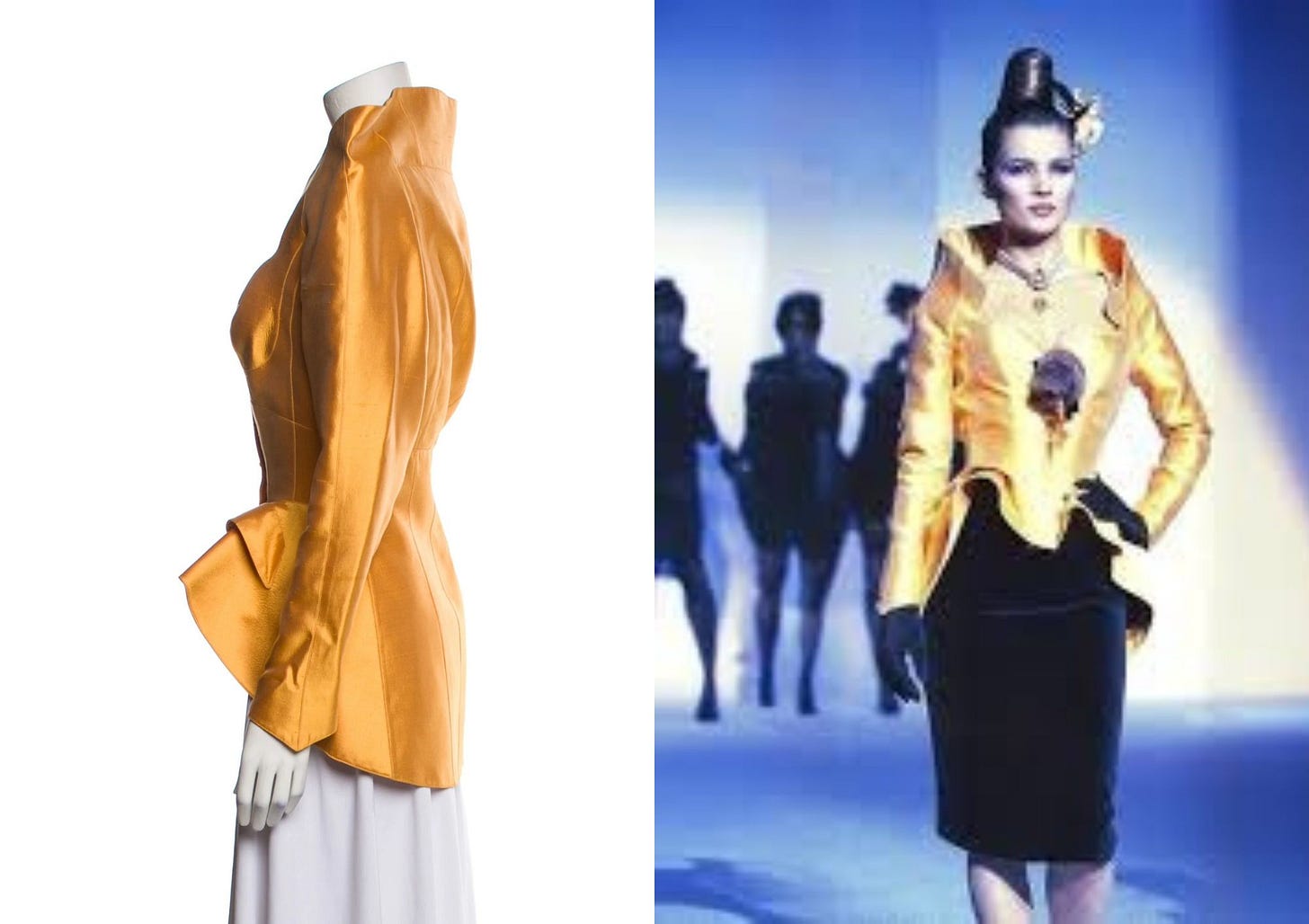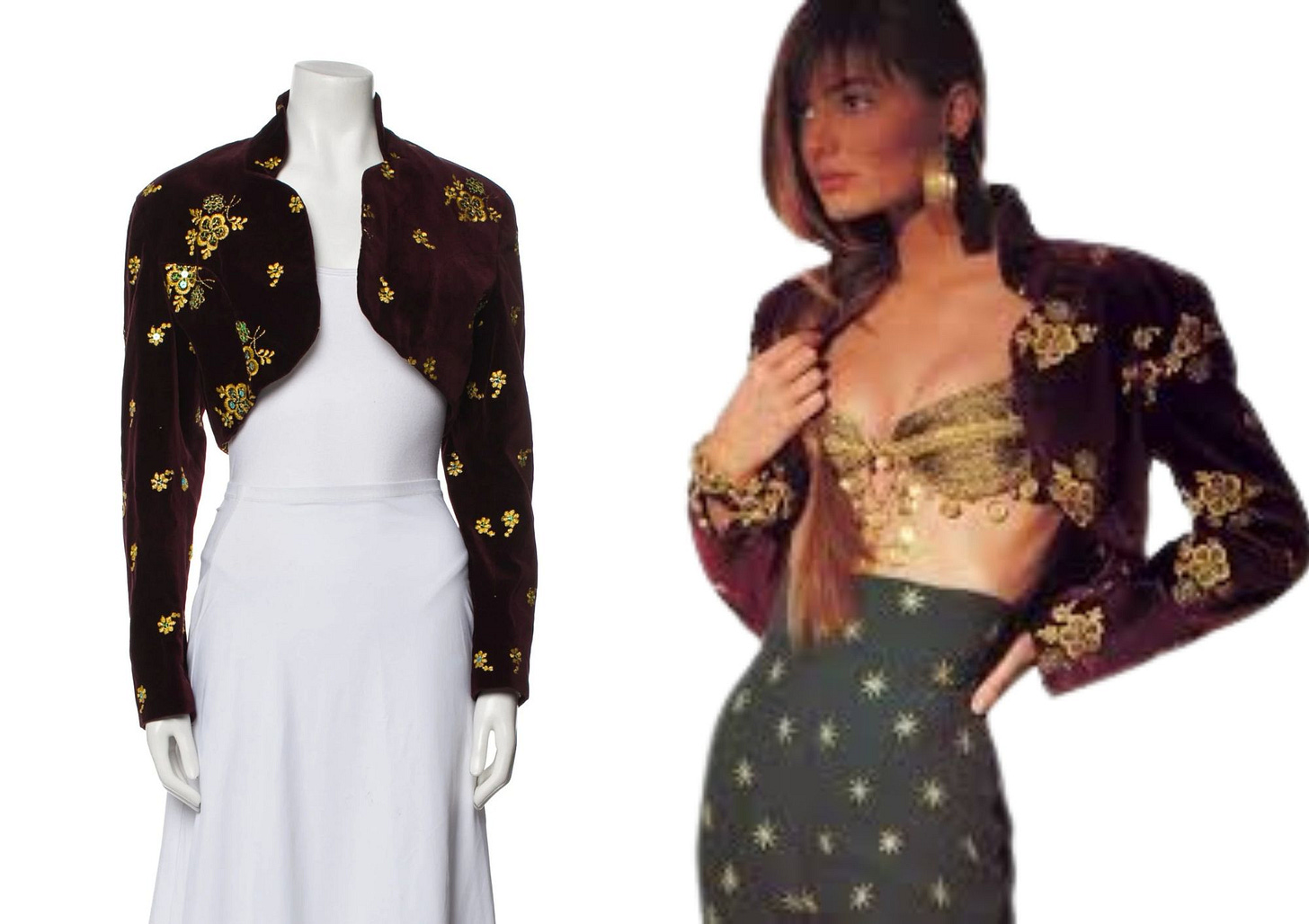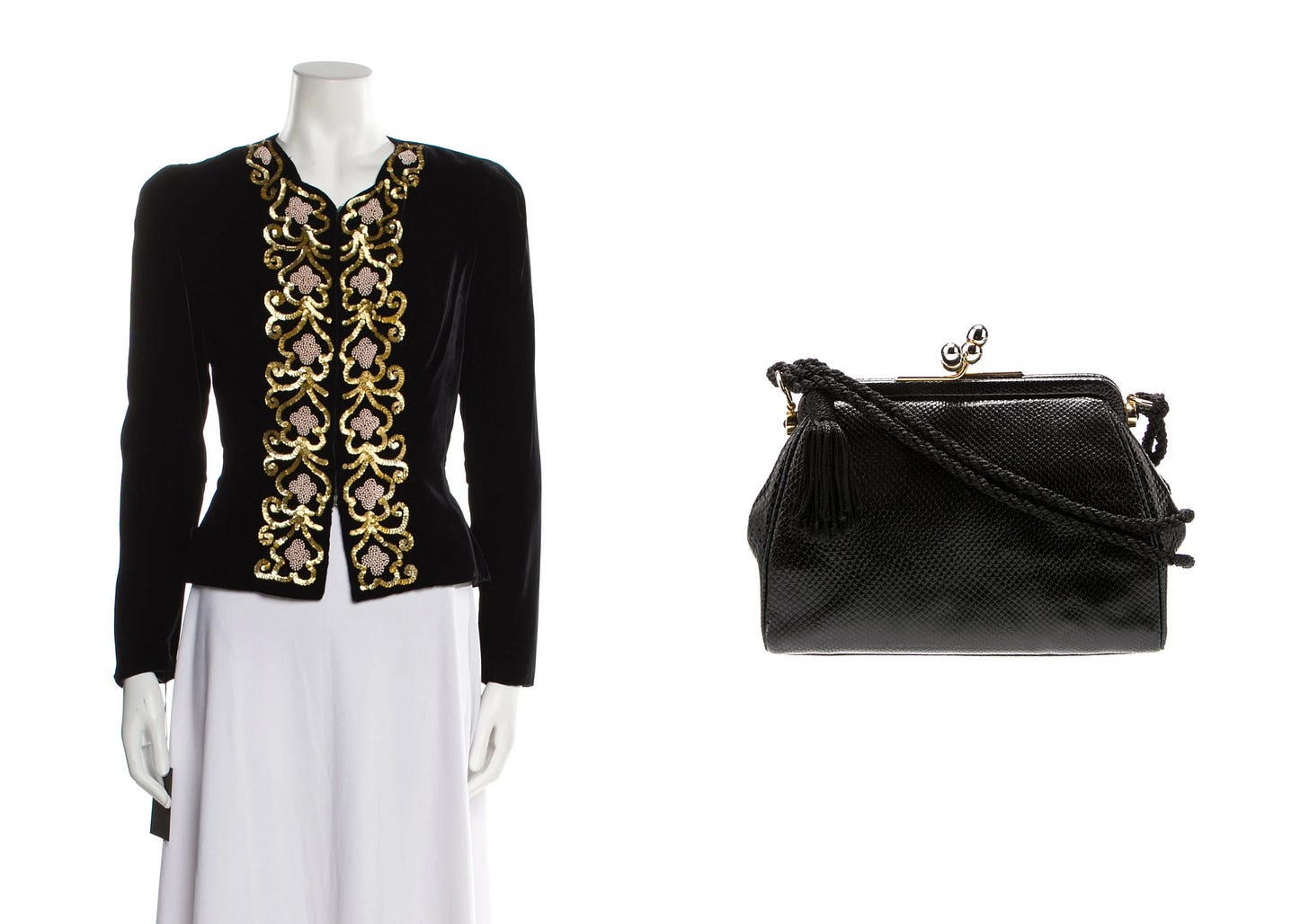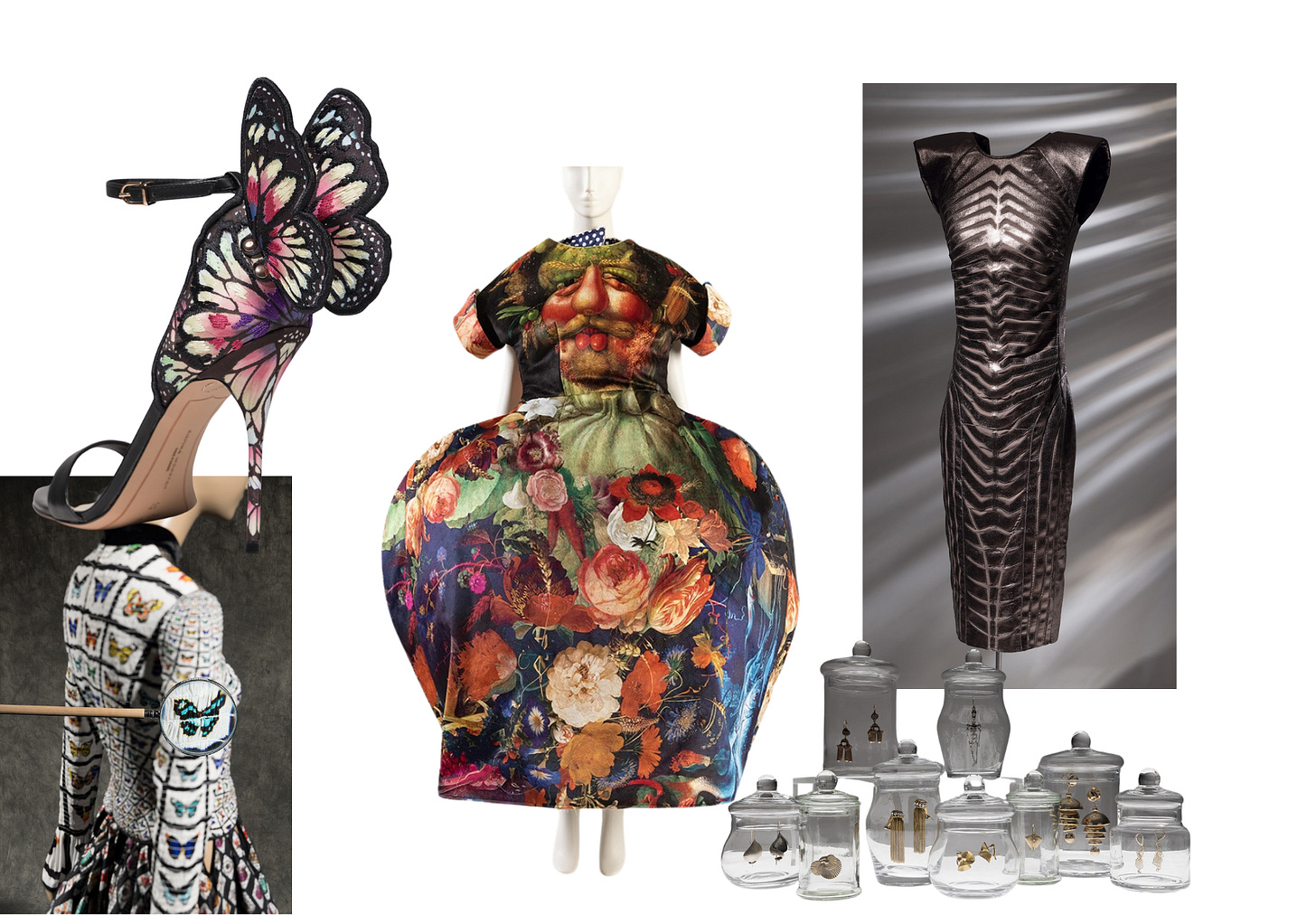The Cartier Trinity You Should Know About, Per Lilah
Plus, a Thierry Mugler Couture jacket (just spotted on the red carpet) and more of my recommendations.
This Week: A runway relic from Thierry Mugler Couture (as seen on Kate Moss in 1995) tops my shopping list. Plus, a lesson in Rifat Ozbek, courtesy of a velvet bolero on The RealReal. Beyond the fashion finds…I recommend trying the Bemelmans Bar that’s about to land in Aspen and reading The Eternal Mysteries of Red.
A Thierry Mugler Moment!
While reviewing the weekend's SNL red carpet parade, my eye caught Anya Taylor-Joy in a marigold, sculptural Thierry Mugler couture jacket—a piece that's been lingering in my TRR obsessions for weeks. It’s high time she led a Per Lilah send. This jacket belongs to a stellar Mugler collection—the very same that gave us Zendaya’s sexy-robot suit for the Dune II premiere. Watching the full (hour-long!) runway show is pure entertainment, and there’s young Kate Moss striding in your future jacket. And though it’s undoubtedly a statement, it’s surprisingly unintimidating. Anya Taylor-Joy proved it—styled right, it wears like a dream, not the other way around.
A Rifat Ozbek Worthy of Irving Penn
Rifat Ozbek, the Turkish designer who ruled the turn of the millennium, is often credited with sparking the '90s obsession with minimalism—his all-white 1990 collection is the stuff of fashion lore. But his range extended far beyond clean lines, as evidenced by this velvet-embroidered bolero from Fall 1989, currently unearthed on The RealReal. It’s so exquisite that Irving Penn immortalized it in Vogue’s October 1, 1989, issue. Look below: model Paulina Porizkova in the exact piece. “Rifat Ozbek heaps riches on richness, embroidering a velvet bolero and pants with gold, decorating a bra with coins,” Vogue wrote. More on Ozbek awaits in this week’s You Really Should Know This (below).
A Charlotte-Approved Cartier Bag
In Sex and the City Season 4, Episodes 3 and 4, Charlotte York carries a Cartier Trinity bag—an accessory as timeless as the jewelry that inspired it. The Trinity collection, born in 1924 from Louis Cartier’s imagination, features three interlocking bands of yellow, white, and rose gold. Style icons like Grace Kelly and Romy Schneider (who famously received a Trinity ring from Alain Delon) cemented its legend. Nearly a century later, Cartier released a line of Trinity handbags to mark the motif's centennial—but Charlotte’s early-2000s version remains the grail. It’s the more faithful take: accordion-like pleats, three-ring closures, and an air of polished pragmatism. If you’re a Charlotte (honorable mention to Kristin Davis’s podcast Are You a Charlotte?), this bag belongs on your arm.
More Chic Things—No Context Needed
Giannini-Era Gucci
With news of Sabato De Sarno’s exit from Gucci, let’s revisit the Frida Giannini years—a less fêted era, perhaps, but one I adored. (She followed Tom Ford and preceded Alessandro Michele.) Case in point: this fall 2014 shift dress, trimmed in leather and punctuated by horsebit hardware trailing down the neckline. It’s quintessential Gucci—equestrian, subtly sexy, logo-free. Bellissima!
Bemelmans Goes West!
Bemelmans Bar isn’t just a bar—it’s a Manhattan institution, known for its golden-glow ambiance and the whimsical murals Ludwig Bemelmans painted in exchange for a year’s stay at The Carlyle. Now, for the first time, that magic has landed in Aspen, thanks to a collaboration with Mytheresa.
New York artist Xavier Donnelly, known for his vibrant, narrative-driven illustrations, reimagines Bemelmans’ iconic scenes with an alpine twist, while red-jacketed bartenders glide past with martinis and sidecars. There’s even a “Press for Fashion” button, serving up curated style alongside cocktails.
Catch it daily from 3 to 9 PM through March 2, 2025, at 620 East Hyman Avenue for the chicest way to après-ski!
Exhibition Wunderkammer
Fashioning Wonder at The Museum at FIT (through April 20, 2025) is less an exhibition and more Wunderkammer, where fashion is the rarest treasure of all. Nearly 200 garments and accessories blur the line between clothing and curiosity—think a butterfly-laden Mary Katrantzou gown, Tom Ford’s zebra-striped dress with a horsehair mane, and a Comme des Garçons jacket printed with an Arcimboldo painting.
Organized into ten playful themes—“Specimens,” “Illusions,” “Treasures”—the show proves that the natural world has always been fashion’s most bountiful muse, inspiring designers to turn flora, fauna, and fantasy into something sublime.
Before “bohemian luxury” became a genre, Rifat Ozbek was defining it. Born in Istanbul and trained at Saint Martin’s, Ozbek brought a worldly, almost nomadic sensibility to fashion in the late 1980s and ’90s, blending Ottoman influences with sharp tailoring, folkloric embroidery with modern ease. Like John Galliano, he was a designer with a deep sense of storytelling—his collections felt like passages from a well-traveled diary, filled with silk kaftans, velvet boleros, and rich, talismanic ornamentation.
His Fall 1989 collection, for example, was a study in opulence—so striking that Irving Penn immortalized one of its embroidered velvet boleros on Paulina Porizkova for Vogue. Yet Ozbek was just as adept at stripping things back, as seen in his all-white 1990 collection, often credited with sparking the ’90s love affair with minimalism. Twice named British Designer of the Year (1988 and 1992), he was a favorite among fashion insiders before stepping away from the runway to focus on home design with his label Yastik. But his vision—fashion as a form of cultural storytelling—still resonates today.
If you love designers who weave history, craftsmanship, and global influences into their work, you really should know Rifat Ozbek.
Go Red or Go Home
I’ve been wearing the same shade of red-red Gucci lipstick and Essie nail polish for five years, and I feel incomplete without them. Red, after all, isn’t just a color—it’s a commitment. The New Yorker’s Jackson Arn explores this idea in The Eternal Mysteries of Red, a fascinating dive into why red captivates, unsettles, and refuses definition.
From Barnett Newman’s slashed canvas (Who’s Afraid of Red, Yellow, and Blue III) to Vermeer’s Girl with the Red Hat, Arn reveals how red is never neutral: it commands, seduces, warns, and delights. It’s the first color most cultures named, the one that quickens the pulse, and—no surprise—the shade most likely to be politicized, romanticized, or feared.
If you’ve ever felt naked without a red lip or powerless in a sea of neutrals, this essay will remind you why. Red isn’t just worn—it’s wielded.






